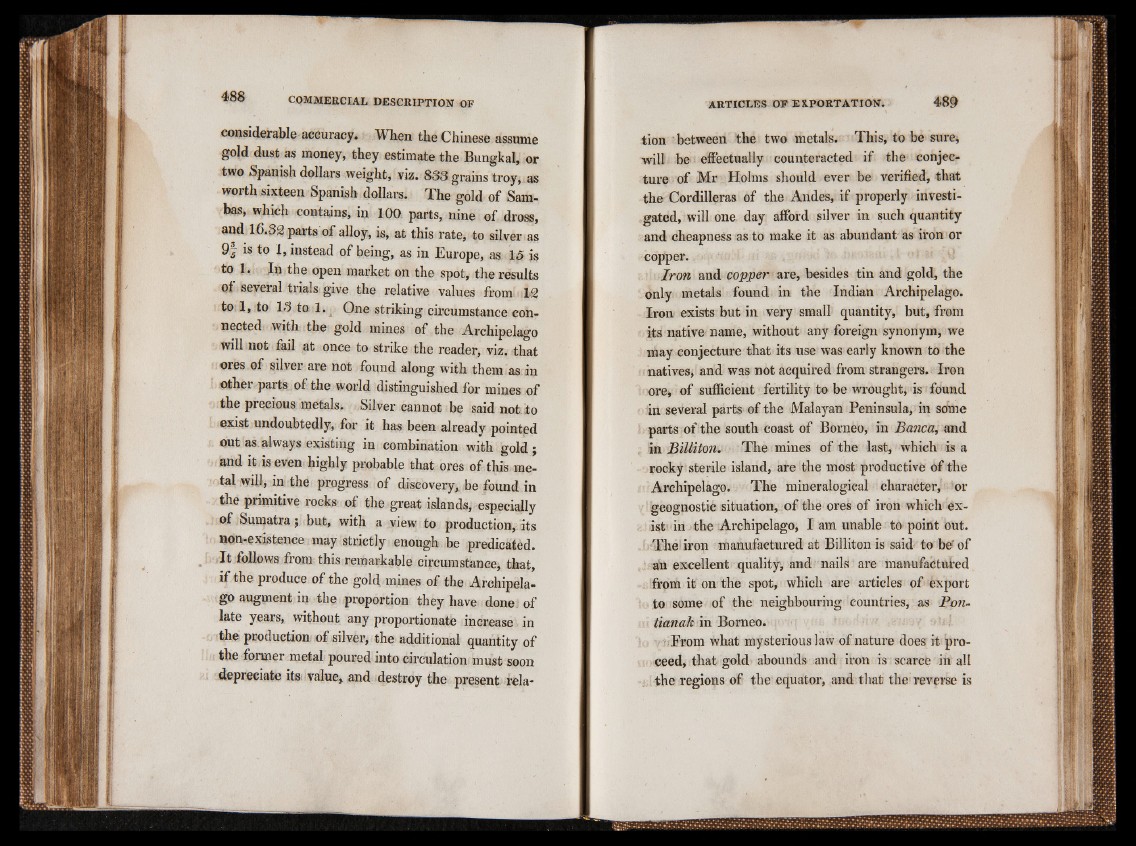
considerable accuracy. When the Chinese assume
gold dust as money, they estimate the Bungkal, or
two Spanish dollars weight, viz. 833 grains troy, as
worth sixteen Spanish dollars. The gold of Sambas,
which contains, in 100 parts, nine of dross,
and 16.32 parts of alloy, is, at this rate, to silver as
9 j is to 1, instead of being, as in Europe, as 15 is
to 1. In the open market on the spot, the results
of several trials give the relative values from 12
to 1, to 13 to 1. One striking circumstance connected
with the gold mines of the Archipelago
will not fail at once to strike the reader, viz. that
ores of silver are not found along with them as in
other parts of the world distinguished for mines of
the precious metals. Silver cannot be said not to
exist undoubtedly, for it has been already pointed
out as always existing in combination with gold;
and it is even highly probable that ores of this metal
will, in the progress of discovery, be found in
the primitive rocks of the great islands, especially
of Sumatra; but, with a view to production, its
non-existence may strictly enough be predicated.
It follows from this remarkable circumstance, that,
if the produce of the gold mines of the Archipelago
augment in the proportion they have done ; of
late years, without any proportionate increase in
the production of silver, the additional quantity of
the former metal poured into circulation must soon
depreciate its value, and destroy the present relation
between the two metals. This, to be sure,
will be effectually counteracted if the conjecture
of Mr Holms should ever be verified, that
the Cordilleras of the Andes, if properly investigated,
will one day afford silver in such quantity
and cheapness as to make it as abundant as iron or
copper.
Iron and copper are, besides tin and gold, the
only metals found in the Indian Archipelago.
Iron exists but in very small quantity, but, from
its native name, without any foreign synonym, we
may conjecture that its use was early known to the
natives, and was not acquired from strangers. Iron
ore, of sufficient fertility to be wrought, is found
in several parts of the Malayan Peninsula, in sotne
parts of the south coast of Borneo, in Banca, and
in Billiton. The mines of the last, which is a
rocky sterile island, are the most productive of the
Archipelago. The mineralogical character, or
geognostie situation, of the ores of iron which exist
in the Archipelago, I am unable to point out.
The iron manufactured at Billiton is said to be' of
an excellent quality;, and nails are manufactured
from it on the spot, which are articles of export
to some of the neighbouring countries, as Bon-
tianalc in Borneo.
¡From what mysterious law of nature does it proceed,
that gold abounds and iron is scarce in all
the regions of the equator, and that the reverse is